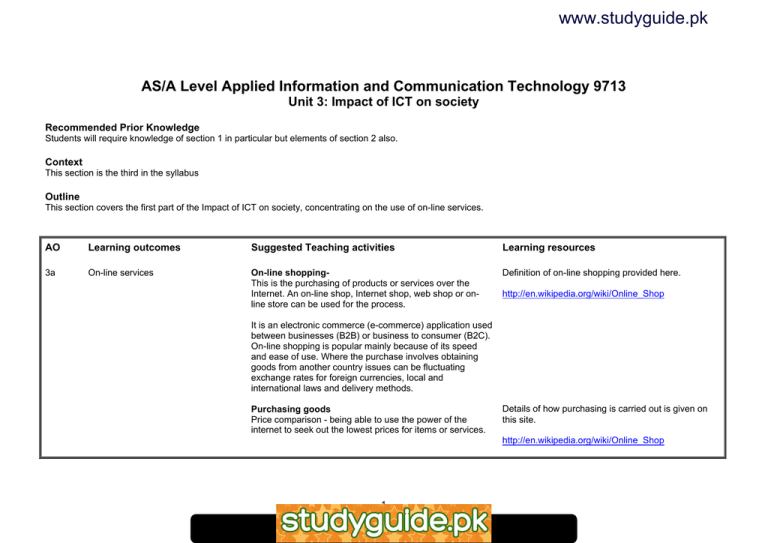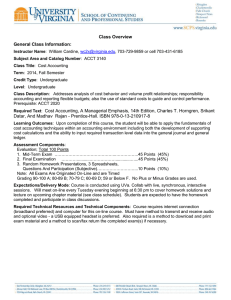www.studyguide.pk AS/A Level Applied Information and Communication Technology 9713
advertisement

www.studyguide.pk AS/A Level Applied Information and Communication Technology 9713 Unit 3: Impact of ICT on society Recommended Prior Knowledge Students will require knowledge of section 1 in particular but elements of section 2 also. Context This section is the third in the syllabus Outline This section covers the first part of the Impact of ICT on society, concentrating on the use of on-line services. AO Learning outcomes Suggested Teaching activities Learning resources 3a On-line services On-line shoppingThis is the purchasing of products or services over the Internet. An on-line shop, Internet shop, web shop or online store can be used for the process. Definition of on-line shopping provided here. http://en.wikipedia.org/wiki/Online_Shop It is an electronic commerce (e-commerce) application used between businesses (B2B) or business to consumer (B2C). On-line shopping is popular mainly because of its speed and ease of use. Where the purchase involves obtaining goods from another country issues can be fluctuating exchange rates for foreign currencies, local and international laws and delivery methods. Purchasing goods Price comparison - being able to use the power of the internet to seek out the lowest prices for items or services. Details of how purchasing is carried out is given on this site. http://en.wikipedia.org/wiki/Online_Shop 1 www.xtremepapers.net www.studyguide.pk AO Learning outcomes Suggested Teaching activities Learning resources Steps when buying on-line - browsing product categories, putting items into a virtual shopping cart. Going to the checkout, confirm the order and logging out Means of payment – there are several methods that on-line shoppers commonly use. this site is typical of the many on-line shopping sites. http://www.amazon.com Security issues – how user and payment data are encrypted and how privacy of personal information remains a big issue. Show your students how shopping is done by going to Amazon which allows you to set up a shopping cart without having to log on. Selling goods The website opposite is very useful and covers much of what students will need to know. How businesses can sell goods is described here. How businesses can operate on-line shopping by setting up a shopping cart system how individuals can sell goods is given here. http://en.wikipedia.org/wiki/Online_Shop http://en.wikipedia.org/wiki/Online_auction On-line transaction services These are now available in many ways. In the UK people can pay their car tax, their council tax, parking fines and many more. This site gives examples of the online transactions which can be carried out with local councils in the UK. Many banking services are now available such as Paypal which allow you to pay for services. Opposite is an excellent breakdown of the Paypal service but teachers should be aware that this is only one example of many of this type of business and should teach their students that. This site describes the workings of Paypal in great detail. Paypal is a brand name and as such should not be given in 2 www.xtremepapers.net http://www.direct.gov.uk/Homepage/fs/en http://en.wikipedia.org/wiki/Paypal www.studyguide.pk AO Learning outcomes Suggested Teaching activities Learning resources an exam answer by candidates. The general services which are available from this company and many others like it must be studied, however. 3b On-line banking - Opening and maintaining bank accounts This site gives a brief description of on-line banking. Many customers are using on line banking because of the convenience of banking at any time and the reduced amount of time and fuel costs incurred when traveling to and from the bank. Security and fraud are issues which should be considered in some detail by students. http://en.wikipedia.org/wiki/Online_banking The effects of the use of on-line services on employment This site gives the advantages and disadvantages. http://scom.hud.ac.uk/scomrlo/cfp211702/c0264878/1.htm http://www.theteacher99.btinternet.co.uk/theteacher/g cse/newgcse/module8/task5.htm General Staff – unemployment Unemployment has occurred as many jobs involving car workers have been replaced by robots. Many clerical duties involved with applications such as payroll are now performed by computers. Car park attendants have been replaced by microprocessor operated machines. Many shop workers and bank workers have lost their jobs because of on-line services. Technical staff employment opportunities The use of ICT obviously makes more jobs available for technically qualified people such as computer programmers, systems analysts, computer technicians and people who can perform robot maintenance. In addition, call centres have created fresh opportunities particularly for women in the developed countries and for men and women in developing countries. 3 www.xtremepapers.net Jobs that have been lost are described here. http://www.klbschool.org.uk/ict/gcse/theory/5_3/5_3_ 2_employment.htm#lost Jobs that have been created or changed are given here. http://www.klbschool.org.uk/ict/gcse/theory/5_3/5_3_ 2_employment.htm#created www.studyguide.pk AO Learning outcomes 3c The effects of the use of on-line services leading to extra leisure time 3d Suggested Teaching activities Learning resources Staff may work for shorter periods Many people think that the increased use of ICT has caused a reduction in the number of hours employees are required to work. The article opposite gives an objective slant on the argument. There is an argument that the increased use of technology is causing people to take work home and thereby work longer hours. This report comments on whether the increased use of ICT actually does lead to shorter hours and more leisure time. The effects of the use of on-line services on working patterns http://news.bbc.co.uk/1/hi/uk/4658956.stm This site provides a very detailed discussion document. http://www.ogc.gov.uk/embedded_object.asp?docid= 1003714 Job-sharing Job sharing is where two people share the responsibilities of a job that would normally be done by one person. Each person is employed on a part-time basis but together they cover a full time post. This site provides all the features, advantages and disadvantages of job sharing. Part-time working This when people only work a limited number of hours. The advent of on-line services has meant that fewer jobs are available but workers can now work fewer hours. This site provides all the features, advantages and disadvantages of part-time working. Flexible working hours This is the working of an individual when it suits them. The employer decides on the opening hours of the business, say from 8 until 6 and the worker may be required to work 7 hours but can choose when the 7 hours will occur. This site is an example of an employer offering flexible working hours. 4 www.xtremepapers.net http://www.cmb.org.uk/files/ http://www.cmb.org.uk/files/part-time-work.pdf http://www.aston.ac.uk/staff/hr/equalops/policies/Flexi ble_Working_Hours.jsp www.studyguide.pk AO Learning outcomes Suggested Teaching activities Learning resources Working from home With the advent of on-line working many jobs can now be undertaken from home. Benefits for employers - Cost savings, increased productivity, improved motivation, skills retention, organisation flexibility, flexible staffing, resilience and enhanced customer service. Benefits for individuals - reduced travel time and costs, improved work opportunities, less disruption to family life, better balance of work and family life, participation in the local community and flexible hours. This site covers all the aspects of teleworking. http://www.eto.org.uk/faq/faq03.htm Social and economic benefits - reduced traffic congestion, reduced total travel and consequent pollution, wider employment/work opportunities, access to work for people with specific difficulties and economic regeneration. Drawbacks - home based telework is inappropriate for some people, many homes are not well equipped for some kinds of telework, some companies have management systems and cultures that are not (yet) well adapted to the flexibility that telework can entail and not all tasks are best performed in a distributed, self managing environment. In some customer service or sales activities there's an advantage to the kind of team spirit and internal motivation that can best be generated by leaders and managers sitting in with the teams and "leading from the front". Compressed hours This site defines compressed hours. Compressed hours working involves employees working the same number of hours but over a shorter number of days. It usually involves working four or four and a half days http://www.cmb.org.uk/files/compressed-hours.pdf 5 www.xtremepapers.net www.studyguide.pk AO Learning outcomes Suggested Teaching activities Learning resources in a week, or nine days out of ten in a fortnight. Ability to move from branch to branch With many companies having centralised computer systems, it is not as important which office workers operate from. They will still be able to access their work. 3e The effects of the use of on-line services on security of, privacy of and access to personal/ confidential information/ data Need to protect confidentiality of data Confidentiality is ensuring that information is accessible only to those authorized to have access and is one of the cornerstones of Information security. Confidentiality is maintained in most on-line systems by the techniques of modern cryptography. This site covers the need for data security in on-line shopping. http://en.wikipedia.org/wiki/Online_Shop#Security_iss ues This site covers the security required in on-line banking. http://en.wikipedia.org/wiki/Online_banking#Security Data protection legislation Data protection acts exist in most countries. These set down rules for keeping data private as well as confidential. This site provides information about the UK Data Protection Act. http://en.wikipedia.org/wiki/Data_protection_act Social and ethical implications of access to personal information Duty of confidence - Everyone working for or with an organisation who records, handles, stores or otherwise comes across information has a personal common law duty of confidence to clients and to his or her employer. 6 www.xtremepapers.net This site gives an example of how a large organisation such as the UK NHS deals with confidentiality. http://www.merseycare.nhs.uk/content-409 www.studyguide.pk AO Learning outcomes Suggested Teaching activities Learning resources Responsibility for passing on information - Organisations are accountable for their decisions to pass on information. Only the minimum identifiable information should be used. Anonymised information - Where anonymised information would be sufficient for a particular purpose, identifiable information should be omitted wherever possible. Aggregated information - aggregating selective information about a small number of clients may not always safeguard confidence adequately. If confidence is breached - Organisations are strongly advised to include a duty of confidence requirement in employment contracts. Clients who feel that confidence has been breached should be able to use complaints procedures against the organisation. Need for security. Security measures - under the Data Protection Act security measures must be in place within an organisation to protect computerised information. Security methods used in on-line banking are discussed here. http://en.wikipedia.org/wiki/Online_banking#Security Fraud is discussed here. http://en.wikipedia.org/wiki/Online_banking#Fraud Security methods used in on-line shopping are discussed here. http://en.wikipedia.org/wiki/Online_Shop#Security_iss ues 3f The effects of the use of on-line 7 www.xtremepapers.net www.studyguide.pk AO Learning outcomes Suggested Teaching activities Learning resources Increase in RSI It is felt that the increased use of on-line services may have an effect on the degree of RSI which computer users will experience. This is more likely to be the case with the telephone operators at call centres than with other users. Vision and posture problems Upper back and neck problems are often caused by bad positioning of a computer screen, or bad lighting Typical symptoms include neck pain, shoulder pain, weakness of the arm and hand muscles and headaches. Here is a definitive list of RSI ailments services on health and safety http://en.wikipedia.org/wiki/Repetitive_strain_injury This site mentions both posture problems and vision problems. http://www.handbag.com/healthfit/health/deskhealth/ Postural low back pain is caused by prolonged sitting or standing. Visual problems such as eye irritation and eye strain are amongst the most frequently reported complaints by computer users caused by glare from the screen, poor positioning of the screen, improper workspace lighting, and poor quality copy material. Need for increased safety measures against electrocution, fire etc. Safety measures need to be taken at on-line centres. Safety measures should include methods of protection against electrocution – don’t overload sockets, automatic fuse trips etc. The presence of CO2 fire extinguishers etc. 8 www.xtremepapers.net This lists potential health and safety problems with on-line centres. This publication contains a section on electrical safety. http://safety.ngfl.gov.uk/ukonline/pdf/d13.pdf







